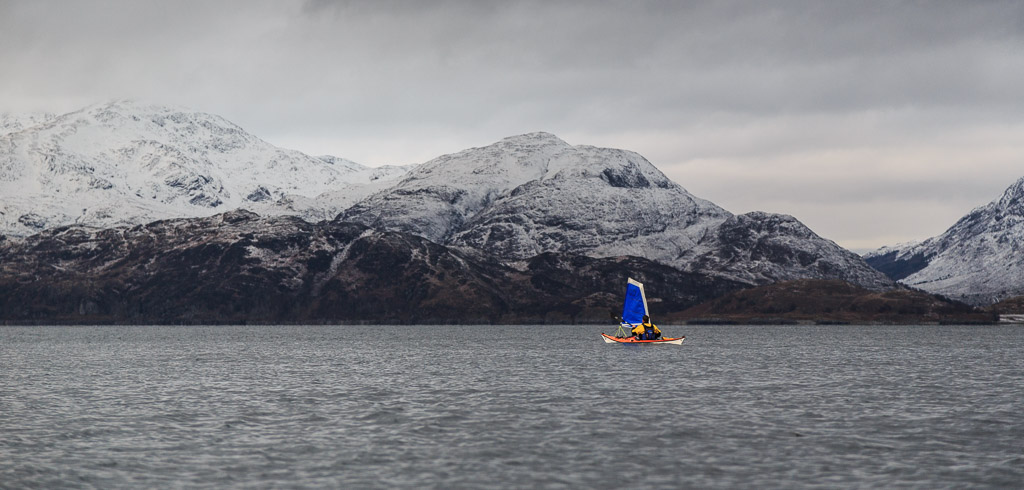I shouted to Mike and Ian to keep a lookout for each other and I hoisted my sail and set off for the headland some 1.1km distant. It was a broad reach with a 3km/hr flood tide running R to L across our path. The water became increasingly confused as we approached the headland as the west going tide, pouring out of the sweep of Cuil Bay, met the main north going flood which had gone up the west side of Eilean Balnagowan. It was superb fun.
I paddle sailed the 1.1km in 5minutes 7 seconds and averaged 12.9km/hr and Mike in the Aries and Ian in the Cetus MV paddled it in 9 minutes 55 seconds and averaged 6.7km/hr.
My Aries was only planing for short distances as the waves were rather short and confused. However, the power of the sail helped me catch just about any wave available, even if only for a short ride. I think the speed difference would have been even greater if we had had more even following seas.
As we proceeded north we gradually entered the lee of the mountains, the wind dropped and...
...Ian and Mike got their sails going again. But soon it was back to...
...paddling until we reached...
...Rubha nam Moine...
...with its distinctive trees. We stopped just round the point where...
...we were joined by some ginger haired locals.
We took a diversion into tiny Kentallan Bay the entrance of which is marked by its distinctive pier house above the old pier.
.
The west side of the bay is composed of the steeply wooded slopes of Ardsheal hill. The Bay is a submerged geological fault and at its head...
...there is an old landing place where...
...the sad remains of a flat bottom turntable ferry. These were used on both the Ballachuilish and Corran routes until the mid 1970's. This one had seen better days, though its engine block was still in situ.
We set off home along the east coast of Kentallen Bay passing...
Ardsheal pier on the way. Steamers used to deliver goods here until the railway from Oban to Ballachilish was built in 1903. At that time a new pier was built beside the Kentallen Railway Station, which is now a hotel. The rock on the north side of Kentallen Bay is an unusual igneous intrusion called Kentallenite.
We hugged the shore to keep out of the increasingly cold wind and before long...
...the Pap of Glencoe reappeared in the east.
Not much remains of...
...the timber part of Ballachuilish Pier but...
...the slates of its stone part are still in good shape.
The flood tide now carried us at a good rate of knots as the snow clouds gathered over the Glen Coe mountains.
It was good to see the hotel coming up and we made sure we broke out of the current in order to land at the old ferry slipway.
The Ballachuillish hotel proved really excellent. After a nice warm bath nothing beats a pint of sports recovery drink by a warm log fire followed by an...
...excellent meal. Mike had mussels to start, Ian had Cullen Skink and I had the vegetarian haggis, neaps and tatties starter. We all had shank of lamb as main course. Yum yum.
All in all another truly excellent day.
































































